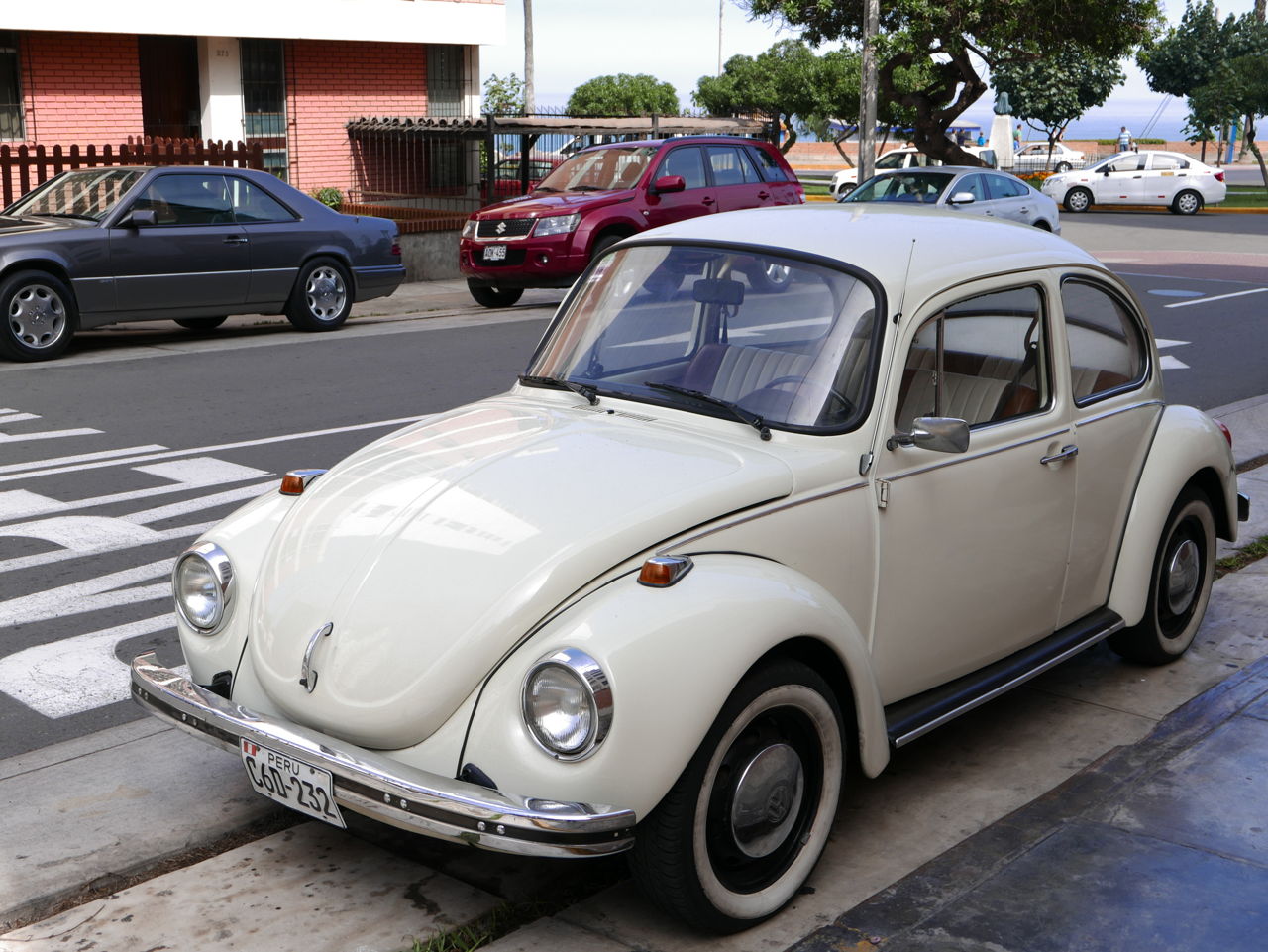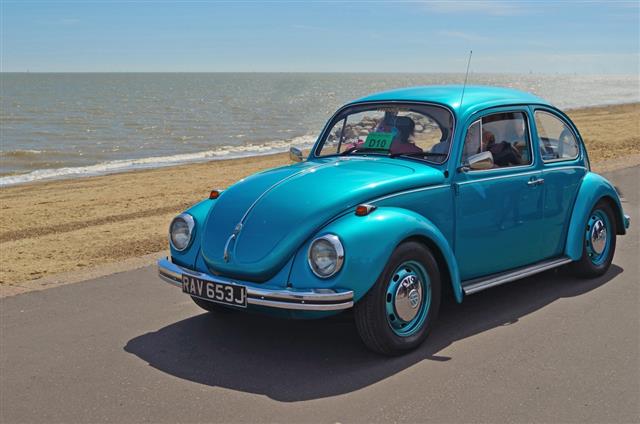
The car which the Fuhrer wanted, a five-passenger vehicle that could travel 62 miles/hr, and was affordable for the general public.
The Volkswagen Beetle, thanks to its distinctive bug-like appearance, is perhaps one of the most popular cars in the world. It has had central casting in the famous ‘Herbie’ movies from 1967 to 1997, it has been the cult car of the Hippie Movement, and, with a well-earned reputation for sturdiness and reliability, it has retained a strong following world-wide – despite the ending of production after an unprecedented 58 year run in 2003.
The Volkswagen Beetle came into existence in Germany, just as the Nazis were coming into power. It was created by Ferdinand Porsche(1875-1952), an already successful German automotive engineer from Vratislavice, Austria-Hungary, who had worked for famous names like Bela Egger, Ludwig Lohner, Daimler, and Steyr, before forming his own company, and designed by his chief engineer, the head of the Porsche car-body-construction department, Erwin Komenda (1904-1966). The design was inspired by that of the famous, technically-advanced Tatra Luxury Cars.
Tatra was a well-known Czech Automobile Company, established in 1850, which had produced Central Europe’s first car, the ‘Prasident’, in 1897, and which perhaps took a close third position after Daimler Mercedes-Benz and Peugeot, in the history of car manufacturing. Tatra was headed by Hans Ledwinka (1878-1967) and his son Erich, who were both business acquaintances of Porsche and had discussed car concepts with him.
Ledwinka was furious to see his ideas plagiarized. However, with Hitler’s invasion of Czechoslovakia, the Ledwinkas discovered better things to worry about than appropriated car designs, and Tatra, which was set to produce cars for German Officers (who crashed so many of them that Tatra came to be known as ‘the Czech Secret Weapon’), didn’t resume the law-suit until after the war. This time, with the Fuhrer out of the way, they were awarded 3,000,000 Deutsche Marks. Tatra has ceased all car production, except heavy-duty trucks, since 1999.
Porsche, prior to the business of the law-suit, originally came up with the new design for Zundapp, a motorcycle manufacturing company that was looking to expand into the automobile industry. In the end though, with the market for motorcycles once again booming, Zundapp decided to stick with what they knew best and leave the car industry alone.
After all the work he had done and the time he had spent, this came as a rude shock to Porsche, so he began looking around for another motorcycle manufacturer to whom to pitch his idea. He got in touch with NSU, who initially seemed enthusiastic about the concept, but then, after long mulling the matter, came to the same decision as Zundapp. This car thing, they said, was too impossibly expensive.
A less determined personality might have lost heart at this stage, but Porsche was not the type of man to be fobbed off with a couple of rejections. It was not for nothing that he had climbed all the way to the top of the Automobile Industry without a formal Engineering Education. He next got in touch with the new German government and received a prompt reply from Adolf Hitler himself.
Hitler was willing to back Porsche if he could come up with a car that met the specifications he had in place. The car the Fuhrer wanted was to be a five-passenger vehicle that could travel 62 miles/hr and had to be affordable for the general public. It was Hitler’s desire that every single German family should be able to have their own vehicle.
Porsche accepted the challenge and set about to create the proposed car. However, despite the Fuhrer’s obvious backing, he was not fully supported by the Reichsverband der Automobilindustrie (the German motor industry association) and so the work proceeded with many hitches and delays. The project, which was originally intended to be finished within 10 months, took two years for completion.
In the end, Porsche and his team of engineers had the first prototype ready in 1935. It was a light, inexpensive automobile that had an all-steel construction, ‘bug-eye’ hood headlights (actually the lid of the luggage compartment), rear-hinged doors, and an air-cooled rear-mounted flat-four engine.
The following year, at the 1936 Berlin Auto Show, two other prototypes, a two-door sedan and a convertible, were displayed.
The German Industry Association, not impressed by the designs, pointed out that the cars also failed to come within the proposed price bracket.
However, with the Fuhrer still interested in the project, a grudging approval for producing one million units a year was given. As none of the contemporary German factories had the capacity for such a high production, it was decided to set up a new Volkswagen factory and also a new town, now known as Wolfsburg, for housing the factory workers.
This got underway in 1939, by that time the forthcoming car had been publicized in the Press, dubbed derisively by the New York Times as the ‘Beetle’, and, as mentioned, foisted with a law-suit by Ledwinka. The Germans, however, excited by the idea of owning a car, were not concerned with American opinions or Czech resentment, and signed up in droves for the savings program that would enable them to buy the KDF-Wagen (KDF – Kraft Durch Freude or Strength Through Joy). This was Hitler’s name for the car.
All the grand dreams of the public, however, were shattered by the Fuhrer’s next dream of creating affordable housing for his people in neighboring countries. With the outbreak of the Second World War, the KDF-Wagen or Volkswagen factory was harnessed for war-production and, instead of family cars, began building sturdy military vehicles like the Kubelwagen that were to famously withstand the harsh conditions of wartime North Africa.
After the war, in 1945, the Factory was taken over by the British and was ordered to produce much-needed vehicles for various military and governmental purposes. As a part of war reparations and his role in assisting the Nazi War Machine, there was also some talk of Porsche moving the Factory to France, but that plan fell through and he found himself imprisoned instead for the next 20 months. In his absence, his son Ferry Porsche managed the business. After his release, Porsche became a consultant for Volkswagen and remained so until his death from a stroke in 1951.
Prior to this, in 1947, Volkswagen signed a deal to export cars to the Netherlands, and it was then that the car, now known as the Volkswagen Beetle became, as Hitler had envisaged, available to the general public. This was the start of its amazing popularity.
